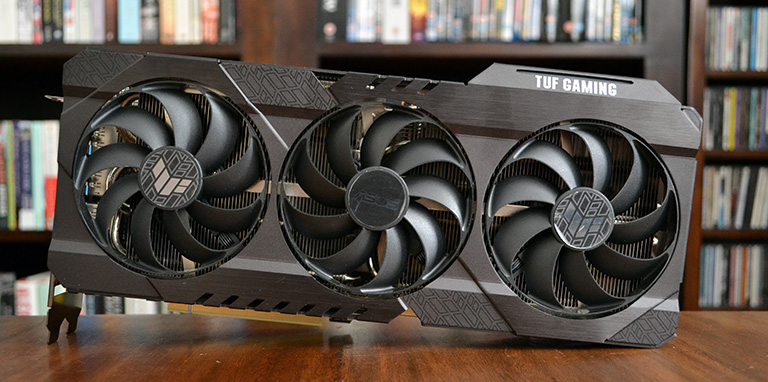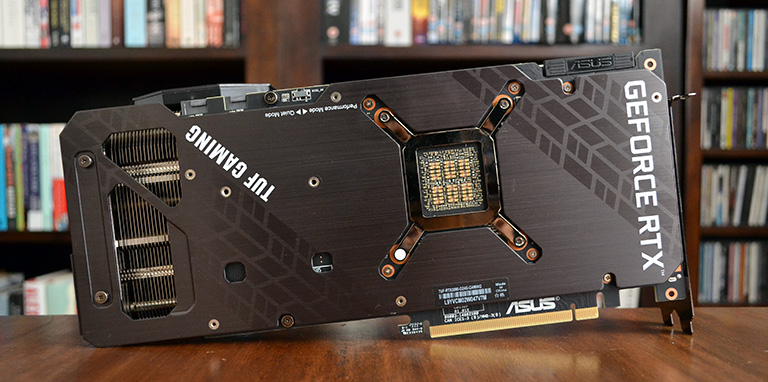Introduction
Though not offering the on-paper value of its RTX 3080 sibling, the £1,500 RTX 3090 remains king of the performance hill, providing 10-15 percent more performance that's most keenly felt at the 4K resolution.
Every board partner building RTX 30-series cards has multiple versions of each model in its arsenal. Asus is certainly no different and populates the monster GPUs with TUF Gaming (OC) and ROG Strix versions. We took a close look at the RTX 3080 TUF Gaming OC in a previous review, which is handy as the RTX 3090 TUF Gaming OC is on the testbench today.
There is little need to change the cooling apparatus as the amount of power needed to be evacuated is similar between GPUs, even if price is not. The RTX 3080 model is said to draw 340W while the RTX 3090 pulls approximately 360W.
As before, build quality is top-notch. The all-aluminium shroud has no flex, and the trio of fans switches off at temperatures below 55°C. When they do come back on, the transition is smooth in both speed and noise. The centre fan rotates in the opposite direction to the outer duo, and Asus claims this reduces cross-fan turbulence. However, on this RTX 3090 we noticed the fans would switch on momentarily when subject to very light load - playing a YouTube movie, for example - and then switch off a second later. Barely noticeable in a regular system, but nevertheless not totally quiet at idle.
This 2.7-slot card tips the scales at almost 1.4kg but presents no GPU sag when screwed in properly. Take note of the capacitors on the back. Our review model features only MLCC capacitors for decoupling close to the GPU; first-run versions, not available to the public, used SP-CAP. The purpose for highlighting this change rests with the ongoing issues experienced by some users, where the choice of capacitors impacted upon stability by not sufficiently keeping up with varying voltage demands caused by too-aggressive changes in GPU frequency.
Nvidia says it has addressed this issue with a new driver, which smooths out the GPU boost frequency, while partners have fervently released stability-related updates of their own. All that said, we experienced no problems on either an AMD Ryzen 9 3950X or Intel Core i9-10900K system. This SLI-capable TUF Gaming OC offers a choice of two BIOSes; one for performance (default) and the other primed for quietness. Asus reckons the quiet BIOS sacrifices 9°C temperature for a 5dB quieter experience. We'll show you what we found later in the review.
The RTX 30-series TUF Gaming OC cards share the same dimensions of 300mm length, 127mm width and 52mm thickness. That's large by anyone's definition, but not silly; the Strix models are bigger still. RGB is limited to the TUF logo on the left, and power is sourced by a couple of 8-pin connectors, which is ample as overclocking headroom is limited. Nevertheless, Asus recommends an 850W PSU if running with either Ryzen 9 or Core i9.
Underneath the six-heatpipe heatsink Asus uses a 20-phase (16+4) power supply for both TUF Gaming OC cards. One would normally say it makes most sense to opt for the cheaper non-OC variant of this product line and overclock to the same levels. That would ordinarily be true, yet the regular TUF Gaming cards use the same 20-phase supply allied to 50A MOSFETs, instead of the 55A found here. Not a major difference, of course, but knowing in any case.
Speaking of TUFs, Asus ships this beast with a 1,740MHz boost clock, up from the reference 1,695MHz. The core frequency is further heightened by installing GPU Tweak II software that offers a 1,770MHz clock. GDDR6X memory, meanwhile, stays at a standard 19.5Gbps.
RTX 3090 carries memory chips on the backside, unlike RTX 3080, so there is intrinsic merit in Asus having a card-wide aluminium backplate with a cut-out for airflow. There are actually two heatsinks present on the top side; the first stretches across the card and primarily cools the GPU and power stages, while the second surrounds the memory and, surprisingly, is imbued with a single heatpipe of its own.
Dual HDMI 2.1 and a trio of DisplayPort offer decent flexibility, though bear in mind that the card can drive four displays at once, not five. Asus says that each card goes through a 144-hour stress test before being certified TUF enough for sale and touts a new I/O bracket with over twice the tensile strength of a normal one. Such implicit reliability and toughness don't translate over to the warranty, which remains an industry-standard three years. We'd really like to see five on this model.
Coming finally to the thorny issue of price and availability. At the time of writing, the card is not in stock anywhere reputable. Pre-order pricing is set at £1,560, but understand very few, if any, retailers are providing a firm delivery date. Patience will have to be a virtue in this case.







